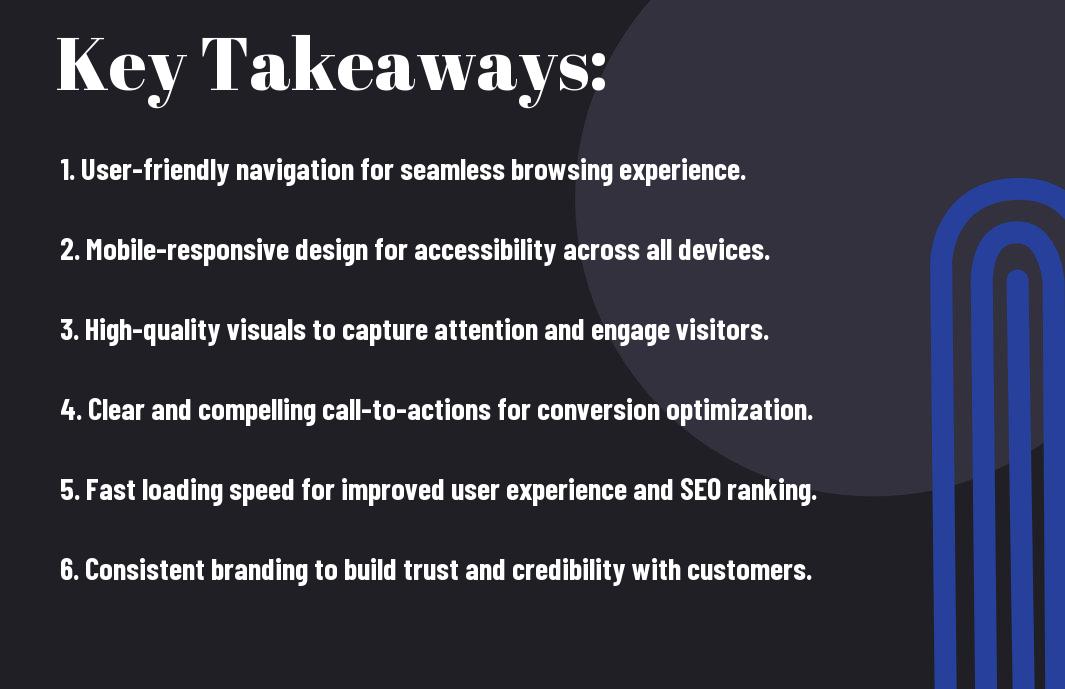Are you looking to take your business to the next level? Your website design could be the key to unlocking its full potential. A professional, user-friendly website can increase customer engagement, generate more leads, and ultimately boost your sales. In this blog post, we’ll explore the importance of a great website design and provide you with tips and tricks on how to create an effective online presence that will set your business apart from the competition. Whether you’re a small startup or a well-established company, having an attractive, functional website is crucial in today’s digital age. So, let’s dive in and learn how you can use your website to propel your business to new heights!
Key Takeaways:
- Professionalism: A great website design can significantly enhance the professionalism of your business, leaving a positive impression on potential customers.
- User Experience: A well-designed website can improve user experience, making it easier for visitors to navigate and find the information they need.
- Brand Image: The design of your website plays a crucial role in shaping your brand image and can help you stand out from competitors.
- Search Engine Optimization: A well-optimized website design can improve your search engine rankings, making it easier for potential customers to find your business online.
- Conversion Rate: A great website design can lead to higher conversion rates, turning visitors into customers and increasing your business’s bottom line.

Design Basics for Business Websites
If you want to boost your business with a great website design, there are a few design basics that you need to keep in mind. Your website design plays a crucial role in how your potential customers perceive your business, make purchasing decisions, and interact with your brand. Here are some design basics that you should focus on to ensure that your website is optimized for success. For more information on how web design can increase leads and sales, check out this informative blog post How Web Design Can Increase Leads & Sales.
Navigational Clarity for Enhanced User Experience
When it comes to website design, navigational clarity is absolutely essential for providing an enhanced user experience. Your website should have a clear and intuitive navigation menu that makes it easy for visitors to find the information they are looking for. Make sure that your menu items are logically organized and easy to understand. Additionally, consider implementing a search function to allow users to quickly find what they need.
Responsive Design for Multiple Devices
In today’s digital world, responsive design is non-negotiable when it comes to creating a successful business website. Your website should be optimized to provide a seamless experience across a variety of devices, including smartphones, tablets, and desktop computers. By ensuring that your website is responsive, you can reach a wider audience and provide a positive user experience for all visitors.

Branding and Visual Elements
Your website is often the first point of contact between you and potential customers. Therefore, it’s crucial that your website design reflects your branding and visual elements effectively. A well-designed website not only represents your brand but also helps to build trust and credibility with your audience. To learn more, you can read our blog post 6 Ways Effective Web Design Can Help Your Business Grow.
Incorporating Brand Identity into Your Design
When designing your website, it’s important to maintain consistency with your brand identity. Your logo, color scheme, and overall aesthetic should be reflected in all aspects of your website design. This helps to reinforce your brand and make it easily recognizable to your visitors. By incorporating your brand identity into your design, you can create a cohesive and memorable experience for your audience.
Using Colors and Images Effectively
Colors and images play a crucial role in creating a visually appealing and engaging website. The use of consistent brand colors can help to create a sense of cohesion and professionalism, while visually representing your brand. Additionally, high-quality images and graphics can help to capture the attention of your audience and convey your brand message effectively. When used strategically, colors and images can enhance the overall look and feel of your website, making it more visually appealing and memorable.
Content and SEO Strategies
To ensure your website effectively boosts your business, you need to focus on implementing strong content and SEO strategies. This will help you attract more visitors, engage your target audience, and ultimately improve your website’s visibility on search engines.
Crafting Compelling Content for Your Audience
When it comes to crafting content for your website, it’s crucial to keep your target audience in mind. You want to create content that resonates with them and provides value. Make sure to understand your audience and their needs, and tailor your content accordingly. Whether it’s blog posts, product descriptions, or landing page copy, your content should be compelling, relevant, and informative.
Optimizing for Search Engines and Improving Visibility
Improving your website’s visibility on search engines is essential for driving organic traffic. To achieve this, you need to optimize your website for relevant keywords and ensure that your content is SEO-friendly. This includes optimizing meta descriptions, title tags, and headings, as well as using internal and external links strategically. By implementing best SEO practices, you can enhance your website’s visibility and attract more organic traffic.
Conversion and User Engagement
For an online business, your website’s success is dependent on its ability to convert visitors into customers and keep them engaged. According to a Forbes article, ‘6 Ways To Improve Your Website Design To Boost Sales’ provides valuable insights into improving your website’s design to increase conversion rates and user engagement.
Design Techniques to Improve Conversion Rates
To improve your website’s conversion rates, it’s essential to prioritize a user-friendly interface and clear call-to-action buttons. Your website’s design should guide visitors towards taking desired actions, such as making a purchase or signing up for a newsletter. Utilizing high-quality images, intuitive navigation, and a mobile-responsive layout can also significantly impact conversion rates. By ensuring a seamless and visually appealing design, you can enhance the overall user experience and encourage visitors to engage with your business.
Analyzing User Data to Refine Website Design
By analyzing user data, such as click-through rates, bounce rates, and time spent on specific pages, you can gain valuable insights into user behavior and preferences. This data can be used to refine your website’s design and content to better cater to your audience’s needs. Implementing A/B testing and heat mapping tools can help you identify areas for improvement and make data-driven decisions to optimize your website’s performance. By continuously refining your website based on user data, you can create a more engaging and personalized experience for your visitors.
Conclusion: How to Boost Your Business with a Great Website Design
On the whole, a great website design can have a significant impact on the success of your business. By focusing on user experience, mobile responsiveness, and visual appeal, you can create a website that not only attracts customers but also keeps them engaged. Remember to prioritize clear navigation and strategic calls to action, as well as search engine optimization to ensure your website ranks well in search results. With a well-designed website, you can establish credibility, build trust, and ultimately drive more conversions for your business. So, invest the time and resources into creating a website that truly reflects the value and professionalism of your brand.
FAQ
Q: Why is website design important for boosting my business?
A: Website design is crucial for creating a positive first impression and engaging customers. A well-designed website can increase brand credibility, customer trust, and ultimately lead to higher conversion rates.
Q: What elements should a great website design include?
A: A great website design should include a clear and intuitive navigation, visually appealing layout, compelling content, strong calls-to-action, and responsive design for mobile devices.
Q: How can website design impact my business’s SEO?
A: A well-designed website can positively impact SEO by improving site speed, user experience, and reducing bounce rates. Additionally, quality content and a well-structured website can help boost search engine rankings.
Q: How can a great website design help in attracting and retaining customers?
A: A visually appealing and user-friendly website design can attract customers and encourage them to explore your products or services. Additionally, a well-designed website can create a positive impression and encourage repeat visits and customer loyalty.
Q: What are some common web design mistakes to avoid?
A: Common web design mistakes to avoid include cluttered layouts, poor navigation, slow loading times, lack of mobile optimization, and outdated content. It’s important to regularly update and optimize your website design to stay competitive in the online marketplace.


